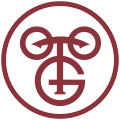|
Coat of arms of Togo
The coat of arms of Togo was adopted on 14 March 1962. Since this Togolese national symbol does not follows the rules of heraldry for a traditional coat of arms, then it could be considered a national emblem instead. In the device, two standing red lions are to be seen, which symbolize the bravery of the people. Both lions are armed with bow and arrow, symbolizing a call for all citizens to be active in the defence of freedom of the country. Between the lions, a golden shield with the letters RT (République Togolaise) is displayed. Above it, the flag of Togo is displayed twice. On a ribbon stands Togo's motto: "Travail, Liberté, Patrie" (Work, Liberty, Homeland).[1][2] After Togo's 1991 National Conference, multiple versions of this emblem proliferated, even within the Togolese government.[3] In June 2008, however, a Constitutional Court decision clarified which version was correct.[4] Official blazonThe coat of arms of the Republic of Togo consists of the following:
Earlier coats of armsProposed arms 1914 In 1914, the German government decided to assign coats of arms to its overseas colonies, including Togoland. Arms were designed, but World War I broke out before the project was finalised, and the arms were never actually taken into use. Giving the colonies their own insignia in time of war could let them have a symbol to rally around in case of rebellion. The arms proposed for the Protectorate of Togoland depicted a tree supported by two cobra snakes and the German imperial eagle on a chief. The eagle and the imperial crown on the shield was the same for all the proposed colonial arms.[5] Seal of French Togoland
References
|
||||||||||

